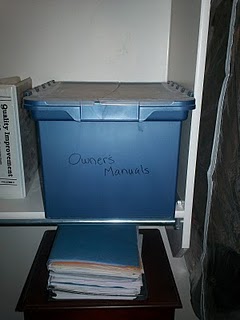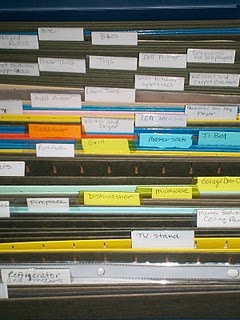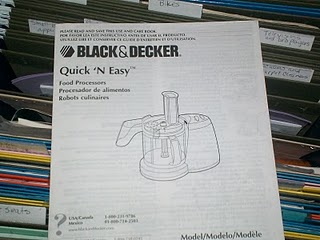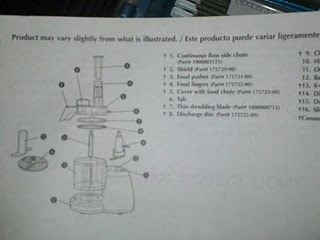I’ve always been pretty good about keeping the owner’s manuals for the things we buy.
A little too good, to be honest. Until last week I had the owner’s manuals for my oldest daughter’s baby toys. She’ll be 25 in December.
I recently took some time to organize them so they’d be easier to find when we need them.
I threw out the ones that went to things we no longer own. And I organized the rest in a file box.
I was specific about some things and general about others.
For example, “toys” are in one file and “small kitchen appliances” are in another. The “water softener” has it’s own. And the files leave plenty of room for small extra parts that might come with things. Like the nuts and bolts necessary to turn my son’s crib into a full size bed one day.
But this post isn’t just about being organized. It’s about saving money too.
Let me explain.
The plastic lid thingy on my food processor broke recently.
I could buy a new food processor for about $40.
Or I could spend a lot of time on the internet trying to figure out the proper name for the plastic lid thingy and then searching for the part number and then search for a place to buy the part.
But, because I held onto the owner’s manual…





Feisty Irish Wench
I have been putting each owner's manual, photocopy of the receipt (heat paper fades quickly) and any warranty papers into a page protector for each item. Those go into a big binder with tab dividers to indicate which area of the house each item belongs. ie: fridge stuff is filed in the Kitchen tab.
Sorensen's
I save all of my manuals. It makes it nice so that when you go to yard sale or sale things you can give the people who are buying your item the manual and I feel like you can ask more money. I have to laugh at what manuals I find when I do go through and organize it.
Shawna
Nice Idea. I seriously needed this post. Thank you tons!
Erica
I do the same as Feisty Irish Wench as well as separate binders for different things – 1 for small appliances/household stuff, 1 for Tools/Lawn equipment (kept in the garage) and 1 that will go with the house if we sell – included in it are the manuals for major appliances but also copies of receipts for all household improvements – paint, towel bars, toilets, faucets, etc. with date installed written down 🙂
Janet Dillon Robinson
Brilliant! I really need to get on this…
Stephanie
I keep owner's manuals, too. Replacements are much cheaper than scrapping the whole item and YES, when you go to sell the item on Craigslist, the owners' manual is a PLUS.